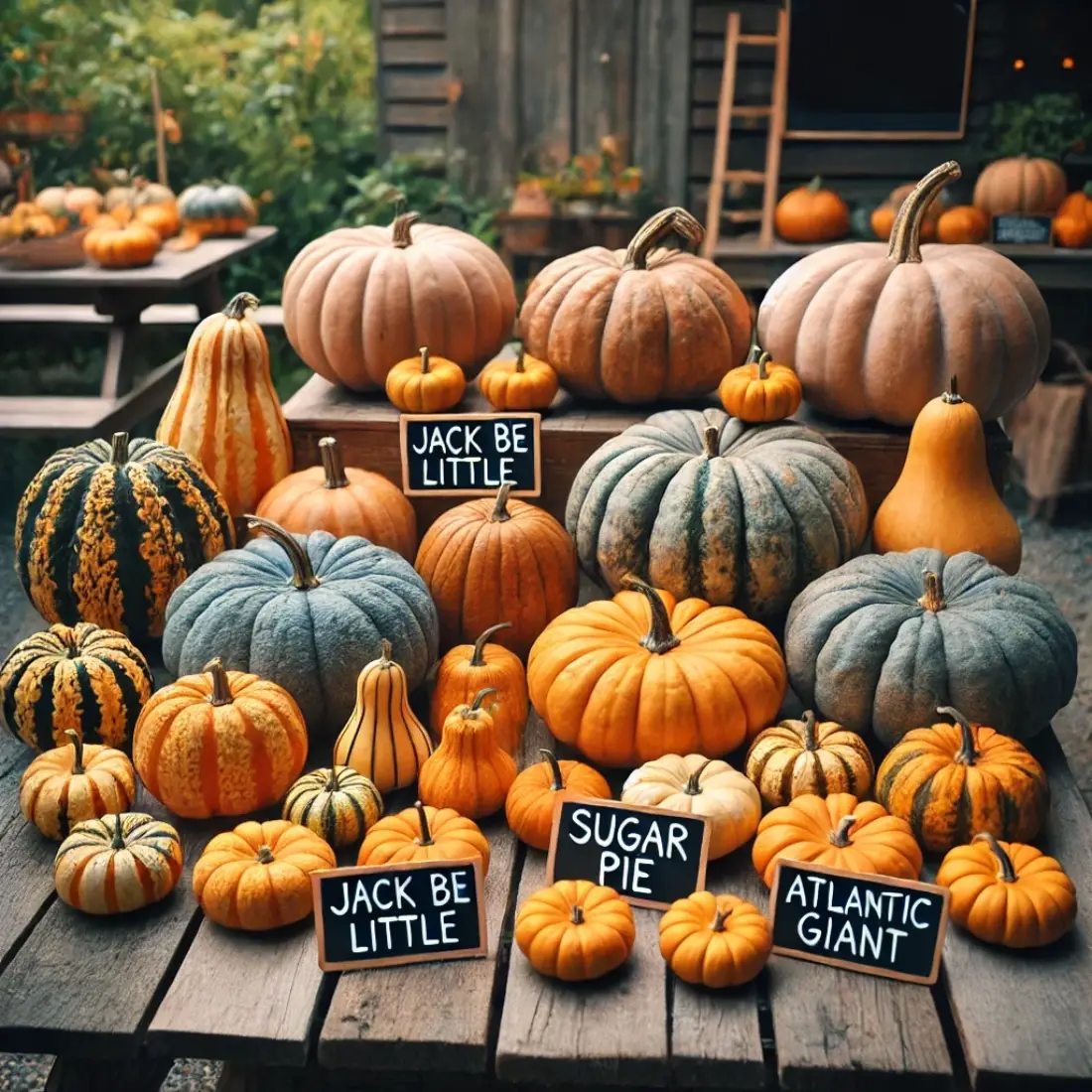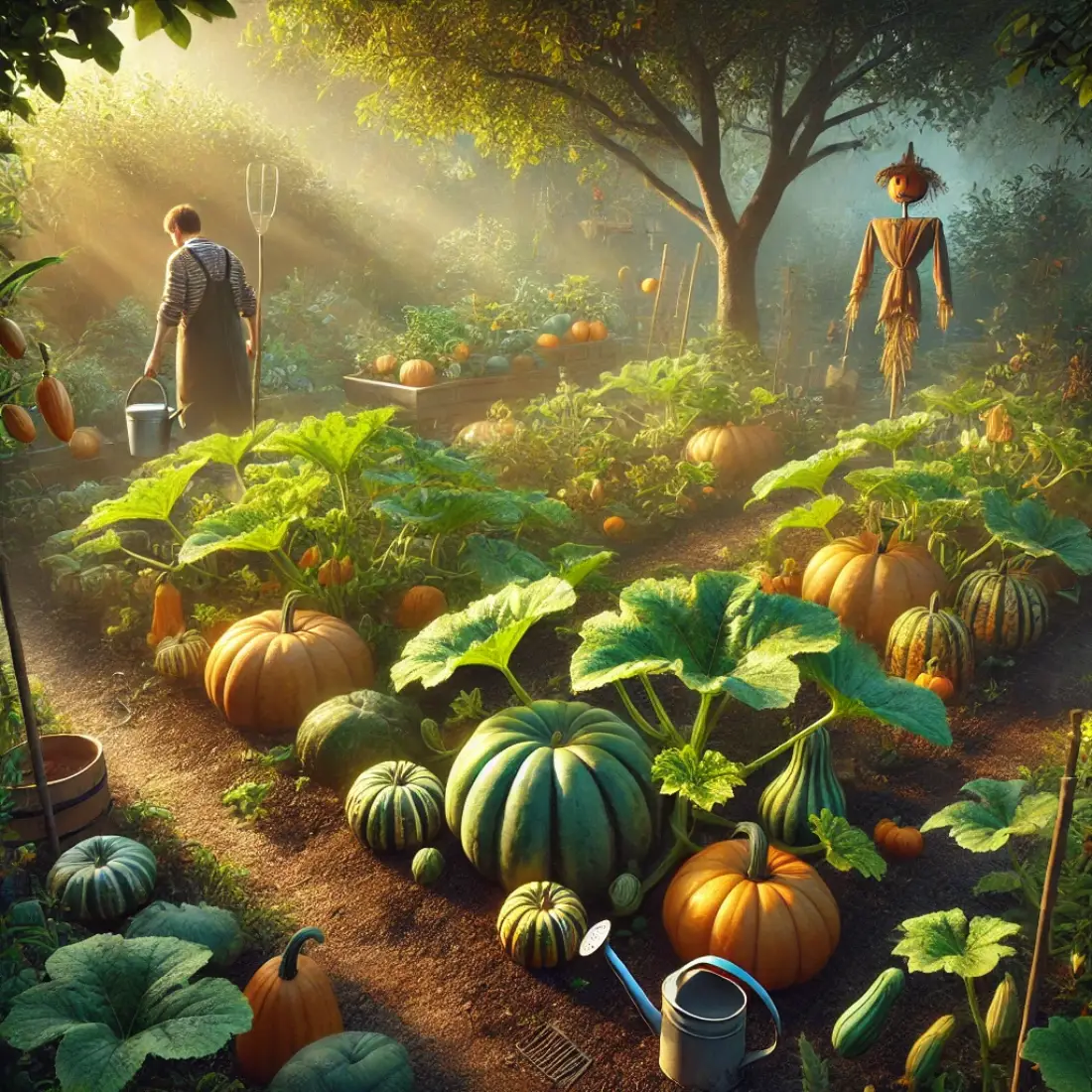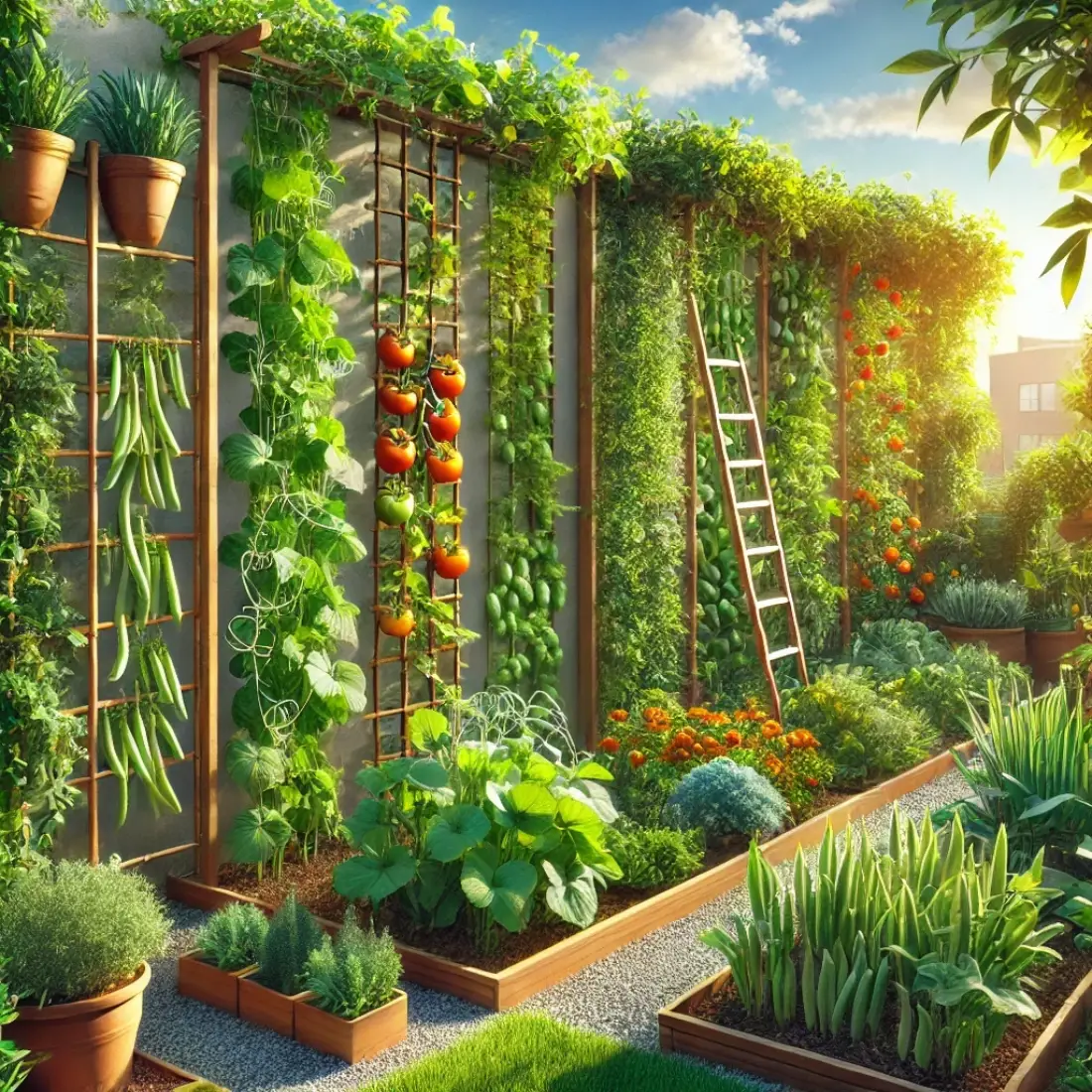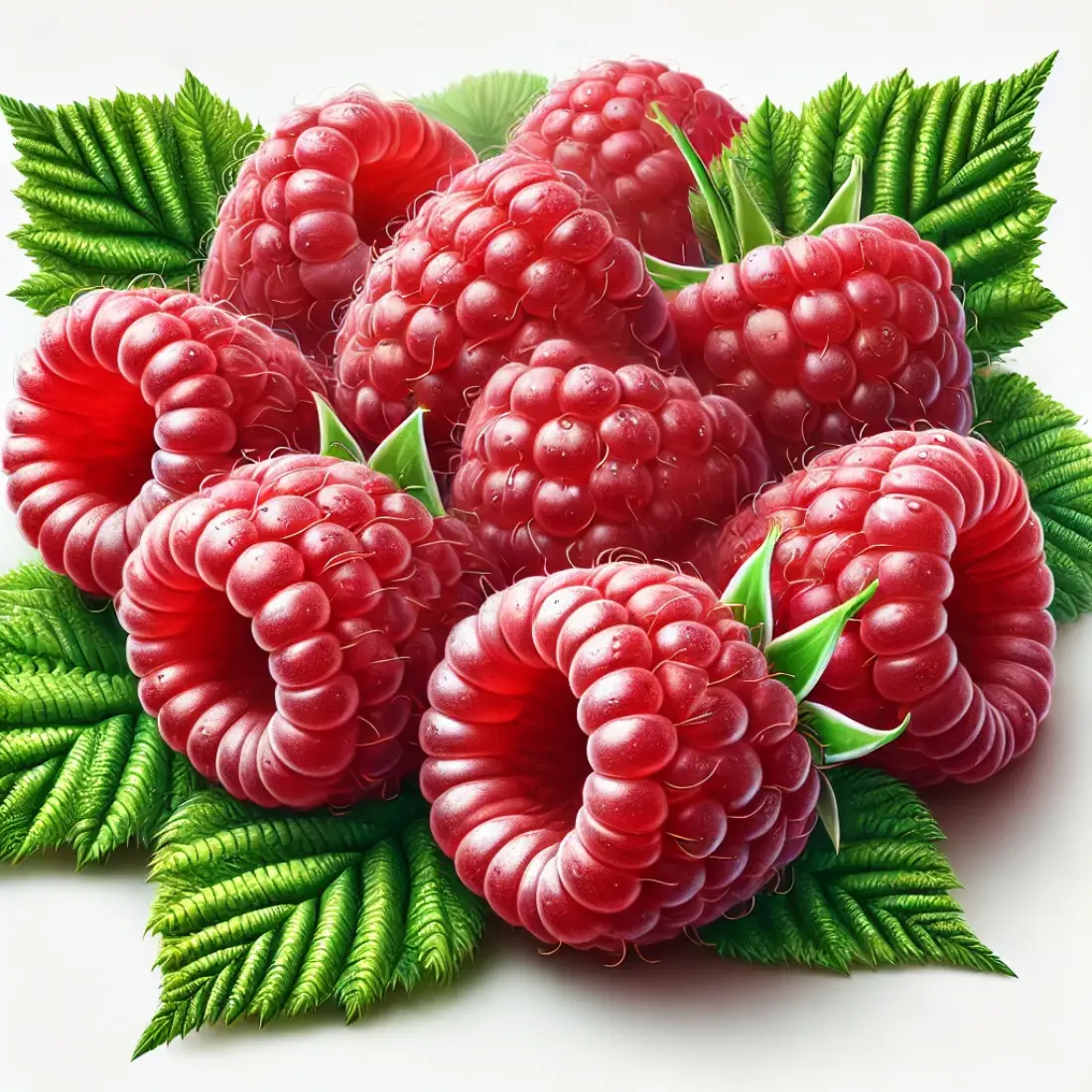Growing pumpkins at home can be a rewarding and enjoyable experience, whether you aim to carve jack-o’-lanterns or bake delicious pumpkin pies. Understanding the essentials of pumpkin care is crucial for achieving a bountiful harvest.
- Choose the right pumpkin variety for home gardening.
- Prepare soil and space properly.
- Follow a consistent watering and fertilization schedule.
- Monitor for pests and diseases.
- Harvest pumpkins at the right time.
Choosing the Right Pumpkin Variety
Choosing the right pumpkin variety is the first step to a successful pumpkin-growing experience. Small varieties like ‘Jack Be Little‘ are perfect for container gardening, while larger varieties such as ‘Atlantic Giant‘ are ideal for those with ample garden space.
For beginners, starting with a variety known for its disease resistance and manageable growth, such as ‘Sugar Pie,’ can be beneficial. Whether you’re aiming for decorative pumpkins or ones for cooking, make sure to select a variety that suits your needs and climate.

Preparing Your Garden for Pumpkins
Before planting your pumpkin seeds, it’s crucial to prepare your garden properly. Pumpkins thrive in well-drained, fertile soil with a pH between 6.0 and 6.8. Start by clearing the area of weeds and debris. Amend the soil with plenty of compost or aged manure to enrich it with nutrients.
Given that pumpkins require a lot of space, ensure that each plant has enough room to sprawl. Generally, planting hills or mounds can help improve drainage and provide a better growing environment.
Planting Pumpkin Seeds
Timing is key when planting pumpkin seeds. Depending on your local climate, you should plant the seeds outdoors after the last frost date. For most regions, this means late spring to early summer.
Plant the seeds 1 inch deep in the soil, spaced about 4-5 feet apart in rows or hills. If you’re using hills, place 4-5 seeds in each hill and thin out the weaker seedlings later. Ensure the soil remains moist to aid in germination, which typically takes 7-10 days.
Watering and Fertilizing Pumpkins
Consistent watering is essential for healthy pumpkin growth. Pumpkins need about 1 inch of water per week, delivered deeply to encourage strong root development. It’s best to water in the early morning to reduce the risk of fungal diseases. In addition to regular watering, pumpkins benefit from fertilization.
Start with a balanced organic fertilizer when planting and switch to a high-phosphorus fertilizer during flowering to promote fruit set. Options like compost tea or fish emulsion can provide necessary nutrients without harsh chemicals.
Caring for Growing Pumpkin Plants
Once your pumpkin plants are established, they need ongoing care to thrive. Regularly check your plants for signs of stress or pests. Prune any dead or damaged leaves to improve air circulation and prevent disease.
Training the vines to grow in a specific direction can help manage space, especially in smaller gardens. Mulching around the base of the plants can help retain moisture and suppress weeds. For larger pumpkins, consider using slings or supports to prevent the fruit from touching the ground and rotting.
Pest and Disease Management
Pumpkins are susceptible to various pests and diseases that can impact their growth and yield. Common pests include squash bugs, cucumber beetles, and aphids. Handpicking, using insecticidal soaps, or introducing beneficial insects like ladybugs can help control these pests. Diseases such as powdery mildew and downy mildew are also common.
Ensure good air circulation by spacing plants adequately and avoid overhead watering. Organic fungicides or homemade remedies like a baking soda solution can help manage these diseases.
Harvesting Pumpkins
Knowing when to harvest pumpkins is crucial to ensure they are ripe and ready for use. Pumpkins are typically ready for harvest 75-100 days after planting, depending on the variety. Look for deep, uniform color and a hard rind.
The stem should be dry and brown. Use a sharp knife or pruning shears to cut the pumpkin from the vine, leaving a few inches of stem attached. Handle pumpkins carefully to avoid bruising, and cure them in a warm, dry place for a week to toughen the skin.
Troubleshooting Common Problems
Growing pumpkins at home can come with its challenges. Yellowing leaves can indicate nutrient deficiencies or water issues. Ensure your plants receive consistent watering and consider a soil test to check for nutrient imbalances.
Poor fruit development can result from inadequate pollination or over-fertilization. Attract pollinators by planting flowers nearby and avoid excessive nitrogen in fertilizers. Regularly inspect your plants for pests and diseases, and take immediate action to mitigate any issues.
Tips for Maximizing Pumpkin Yield
To get the most out of your pumpkin plants, consider implementing strategies to maximize yield. Companion planting with crops like corn or beans can improve growth and pest resistance.
Rotate your crops each year to prevent soil depletion and disease buildup. Enhancing pollination by manually pollinating flowers can also boost fruit set. Additionally, maintaining a healthy, nutrient-rich soil through organic matter and proper fertilization will support robust pumpkin growth.
FAQs about Caring for Pumpkins
How long do pumpkins take to grow?
Pumpkins typically take between 75-100 days to mature, depending on the variety and growing conditions.
Can pumpkins be grown in containers?
Yes, small pumpkin varieties can be grown in large containers with adequate soil depth and space for vine growth.
What are the best companion plants for pumpkins?
Good companion plants for pumpkins include corn, beans, marigolds, and nasturtiums, which can help with pest control and pollination.
How do I prevent my pumpkins from rotting?
Ensure proper drainage, avoid overhead watering, use mulch, and support large pumpkins to keep them off the ground.
How often should I water my pumpkin plants?
Pumpkins need about 1 inch of water per week. It’s best to water deeply and consistently, especially during dry spells.
When is the best time to plant pumpkin seeds?
Pumpkin seeds should be planted outdoors after the last frost date in your area, typically in late spring to early summer.
How do I know when my pumpkins are ready to harvest?
Pumpkins are ready to harvest when they have a deep, uniform color, a hard rind, and a dry, brown stem.
What should I do if my pumpkin leaves turn yellow?
Yellow leaves can indicate nutrient deficiencies or water issues. Ensure consistent watering and consider a soil test to check for nutrient imbalances.
Can I grow pumpkins indoors?
While pumpkins can be started indoors, they require a lot of space and sunlight, making them better suited for outdoor gardening.
How do I improve pollination for my pumpkin plants?
To enhance pollination, plant flowers nearby to attract pollinators, and consider manually pollinating by transferring pollen from male to female flowers with a brush.










